Key takeaways:
- Graphene, discovered in 2004 by Geim and Novoselov, has exceptional properties such as high strength and electrical conductivity, leading to diverse applications in electronics and energy.
- Significant potential uses of graphene include flexible electronics, advanced energy storage solutions, and enhanced medical implants, showcasing its transformative impact across multiple industries.
- Challenges to widespread graphene adoption include high production costs, lack of standardization, and resistance from traditional industries, emphasizing the need for innovation and investment to overcome barriers.
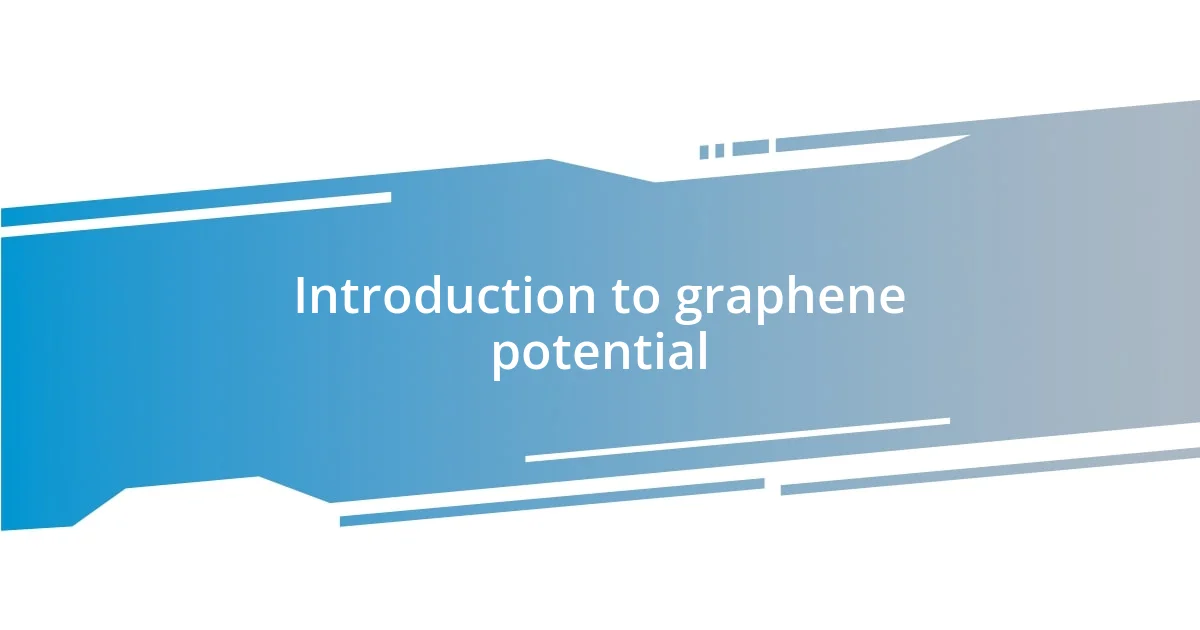
Introduction to graphene potential
Graphene, often hailed as a “wonder material,” is a single layer of carbon atoms arranged in a two-dimensional honeycomb lattice. It’s fascinating to think about how this seemingly simple structure has the potential to revolutionize various industries, from electronics to medicine. Have you ever pondered how such a thin slice of carbon could wield the power to enhance smartphone screens or lead to breakthroughs in sustainable energy?
When I first learned about graphene’s incredible strength, I couldn’t help but draw parallels to my own experiences with resilience. It’s not just about being strong; it’s about how that strength can manifest in innovation. The potential applications of graphene seem almost limitless, leaving me amazed at how it might change our approach to materials science, engineering, and even biological solutions.
One of the most exciting aspects of graphene is its extraordinary electrical conductivity—far superior to copper. Just imagine the possibility of faster, more efficient electronic devices! As I dive deeper into this topic, I often find myself wondering: what else could we achieve if we fully harnessed graphene’s capabilities? The thrill of these unanswered questions keeps me engaged and passionate about exploring graphene’s potential further.

History of graphene discovery
The story of graphene’s discovery is captivating and reminds me of how innovation often arises from unexpected places. In 2004, two researchers, Andre Geim and Konstantin Novoselov at the University of Manchester, managed to isolate graphene using a simple technique involving adhesive tape. What strikes me is how something so profound began with such a humble method. It’s a great reminder that sometimes, the simplest ideas can lead to monumental breakthroughs.
- They used adhesive tape to peel away layers from graphite, eventually obtaining a single layer of graphene.
- Geim and Novoselov’s work was initially met with skepticism, yet it paved the way for graphene to be recognized for its unique properties.
- In 2010, they were awarded the Nobel Prize in Physics for their pioneering work.
- Their discovery sparked a global interest in graphene, leading to extensive research and potential applications across various fields.
Hearing about their journey in a documentary left me inspired. The excitement they expressed when they first observed graphene under an electron microscope was contagious. I think it speaks volumes about how passion, paired with curiosity, can ignite the spark of innovation. Understanding the roots of graphene’s discovery makes me eager to see how it can evolve further.
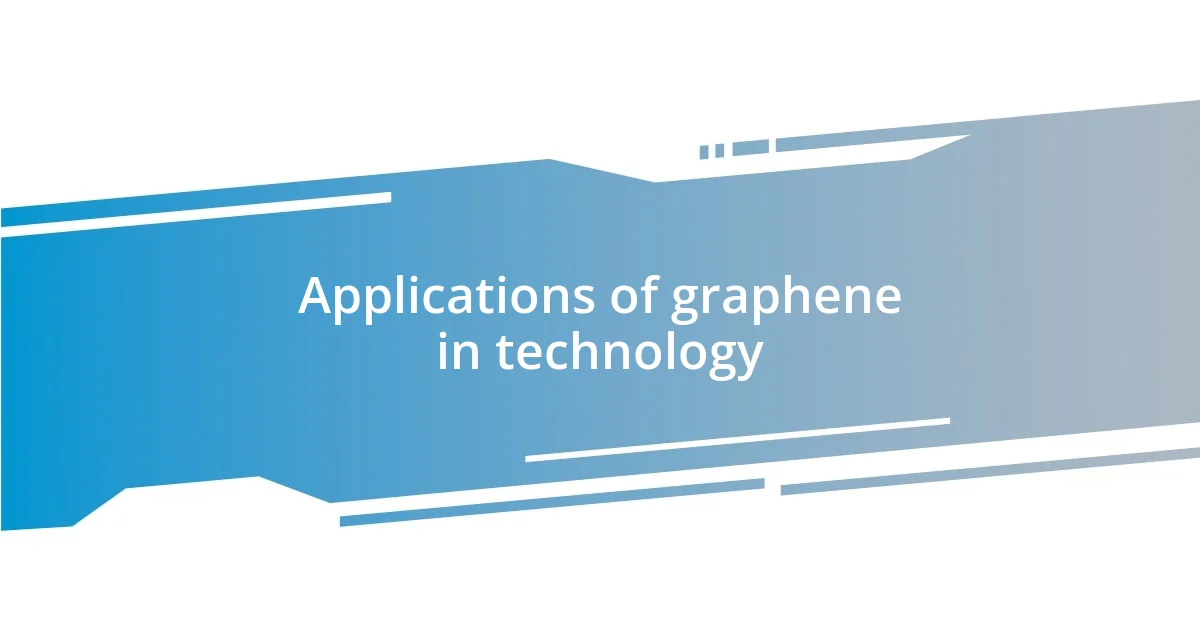
Applications of graphene in technology
Graphene’s potential in technology spans a diverse array of applications that continually astonish me. One area where graphene is making waves is in flexible electronics. I remember the first time I used a flexible display; it felt surreal, almost like I was interacting with a piece of futuristic technology. Graphene’s incredible flexibility and conductivity enable devices that can bend without compromising performance, fundamentally changing how we think about portable technology.
In the realm of energy, graphene is being explored for use in supercapacitors and batteries. These energy storage devices could charge faster and have longer lifespans than current technologies. The idea of a phone that can fully charge in mere minutes feels like science fiction—I can imagine how convenient that would be in my daily life. My experiences with waiting for devices to charge keep me eager for these advancements to become reality.
Graphene also shows promise in enhancing the efficiency of solar cells. The enhanced conductivity allows for better charge collection, which can lead to thinner and more efficient panels. I often think about my experiences with traditional solar panels; they’re bulky and somewhat inefficient. The prospect of lightweight, graphene-enhanced panels excites me—not just for energy efficiency, but for their potential to bring sustainable power to a wider audience.
| Application | Benefit |
|---|---|
| Flexible Electronics | Bends without loss of performance |
| Energy Storage | Faster charging and longer lifespan |
| Solar Cells | Improved efficiency and lightweight design |
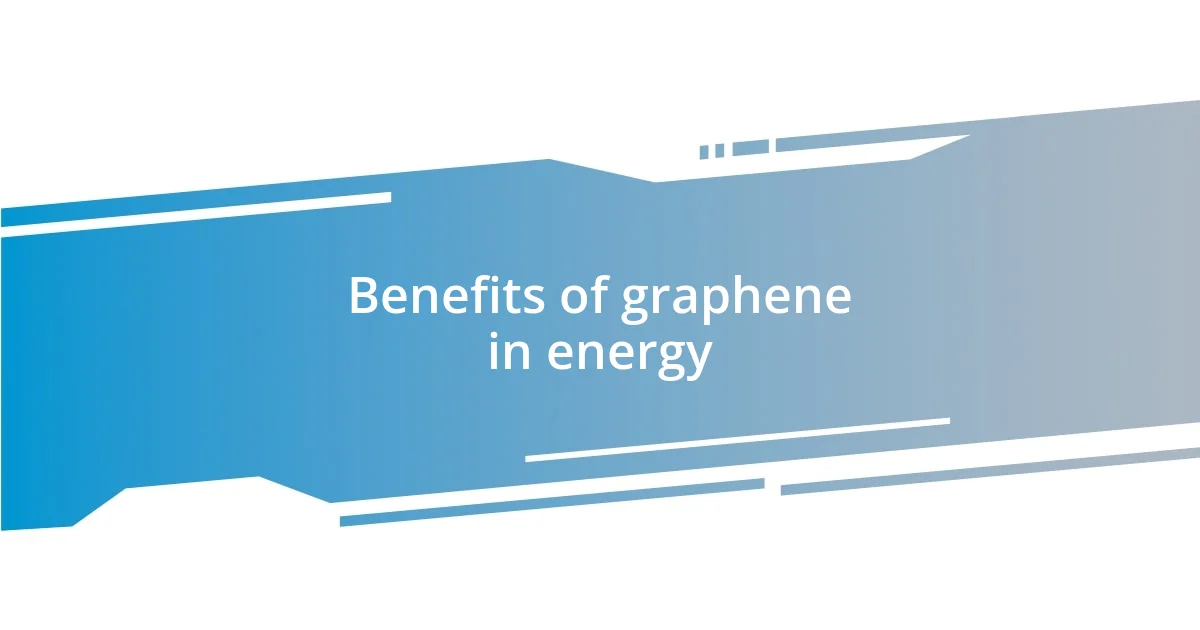
Benefits of graphene in energy
Graphene’s role in energy storage is absolutely fascinating. I recall attending a tech expo where I first encountered prototypes of graphene-based batteries. The presenter showcased how they could charge significantly faster than lithium-ion batteries, and it hit me—this technology could redefine our everyday lives. Imagine being able to charge your devices in just a few minutes instead of waiting for hours. That thought alone gets me excited about the possibility of more efficient energy use.
Moreover, when I learned about graphene-enhanced supercapacitors, I couldn’t help but think about how they could impact renewable energy. Unlike traditional batteries, these devices can store and release energy rapidly. I remember feeling a rush of hope as I considered how this technology could help integrate more renewable sources into our energy grid. After all, solar and wind energy can be sporadic; having a storage solution that reacts quickly to energy fluctuations could make a world of difference for sustainable energy accessibility.
Lastly, the potential of graphene in improving solar panels is particularly striking to me. I often reminisce about my struggles with bulky solar installations that felt inefficient, both in space and energy conversion. Nowadays, I can’t help but daydream about lightweight, graphene-infused solar panels that could seamlessly blend into rooftops and even portable devices. Wouldn’t it be incredible if everyone could harness solar energy without compromising aesthetics? The benefits just keep piling up, showcasing why I am a firm believer in graphene’s transformational potential in the energy sector.

Graphene in healthcare advancements
Graphene is making remarkable strides in healthcare, and I find the implications deeply inspiring. For instance, its incredible strength and lightweight properties are being explored for creating advanced medical implants. I once witnessed a demonstration of a graphene-based implant, and it struck me how it could enhance patient recovery. Imagine a world where implants are not only more durable but also significantly reduce the risk of infection!
Another exciting application is in the field of biosensors. I’ve come across research highlighting how graphene can be used to develop ultra-sensitive sensors capable of detecting diseases at very early stages. This possibility makes me think about how many lives could be saved by catching health issues before they escalate. It’s simply astounding to envision a future where a simple scan could provide a wealth of health information, all thanks to graphene technologies.
Moreover, graphene’s potential in drug delivery systems really captivates me. It can be engineered to carry drugs directly to targeted cells, minimizing side effects and maximizing effectiveness. I remember when my own family member faced chemotherapy; the challenges of managing side effects were overwhelming. How different would their experience have been if we had had access to precise drug delivery methods utilizing graphene? The thought of improving patient outcomes in such a direct way truly reinforces my belief in graphene’s transformative power in healthcare.
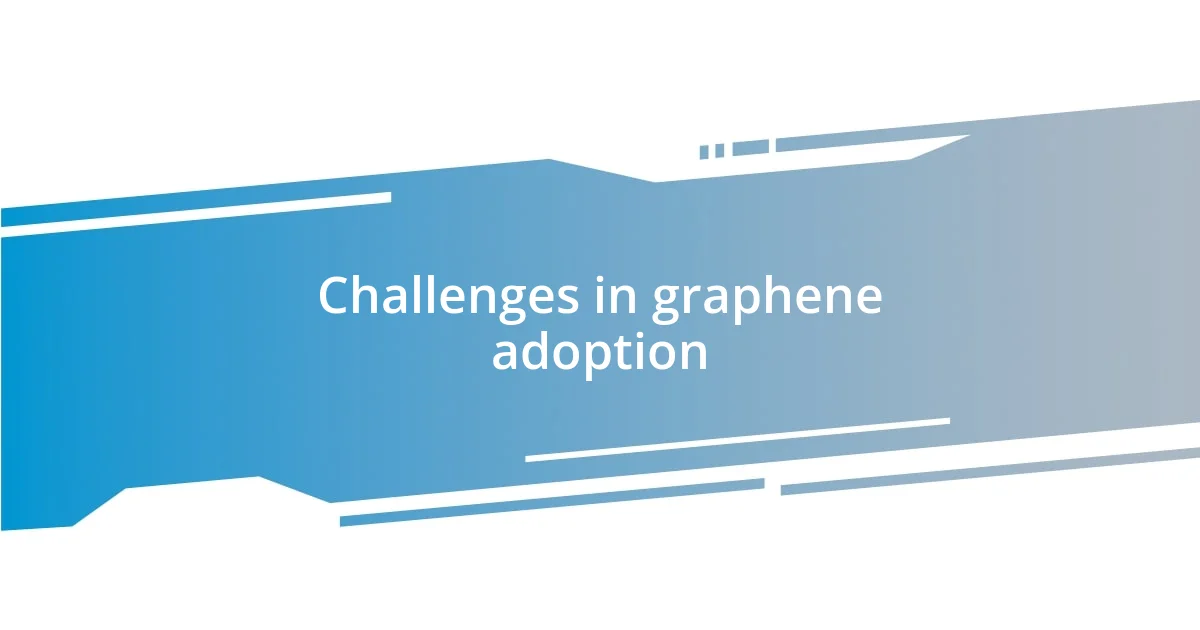
Challenges in graphene adoption
Adopting graphene on a large scale presents several significant challenges. One of the largest hurdles is the cost of production. While my enthusiasm for graphene’s potential is unending, I can’t ignore how expensive it currently is to produce high-quality graphene. When I heard that commercial-grade graphene often comes with a hefty price tag, I started to wonder about how this would limit its accessibility for small businesses and startups eager to innovate.
Another issue is the lack of standardization in graphene production and testing methods. It boggles my mind how a material with so much promise lacks agreed-upon guidelines for its quality assessment. I remember speaking with a researcher who mentioned that variations in properties can make it difficult for companies to know what they’re actually working with. If we can’t ensure consistency, how can we expect industries to trust and invest in this technology?
Lastly, I’ve noticed a hesitancy among industries to pivot towards new materials like graphene. Change is challenging, both logistically and culturally. I have firsthand experience with this, as switching from traditional materials to graphene in my projects often meets resistance from established practices. How do we overcome that inertia? Addressing these challenges requires not just innovation in materials, but also shifts in mindset and investment from businesses willing to take a leap of faith into the future.
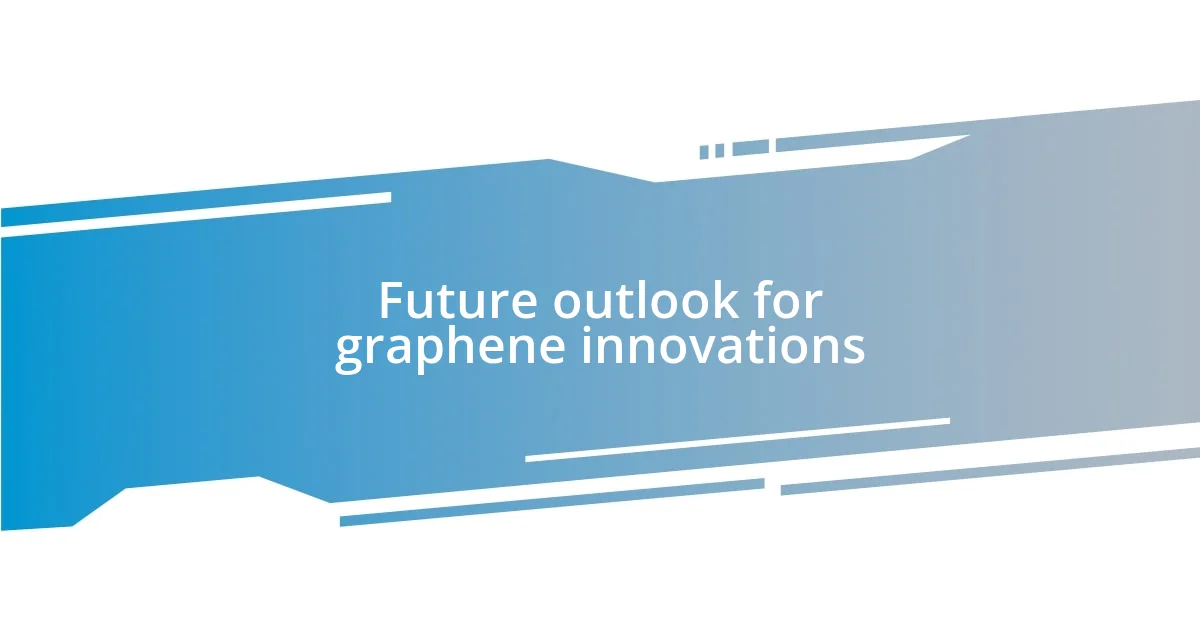
Future outlook for graphene innovations
The future of graphene innovations is incredibly bright, particularly in electronics and energy storage. I recall visiting a tech conference where a start-up showcased a graphene-enhanced battery. The charge time was shockingly fast, and the capacity was double that of conventional batteries! This kind of advancement leads me to wonder: could we soon see electric vehicles that charge in minutes rather than hours?
In addition to batteries, graphene’s potential for flexible electronics really stirs my imagination. I recently read an article about researchers developing foldable phone screens using graphene composites. Picture a day when our devices could bend and twist while still maintaining high performance. That could completely transform our interaction with technology, making it more versatile than ever before.
Moreover, I find the prospect of graphene in environmental solutions particularly inspiring. There’s research suggesting it could be used to create filters that remove contaminants from water more effectively than anything we have today. Imagine the positive impact on global water scarcity if this technology becomes widely adopted! It makes me think about how innovations like these could shape not only our daily lives but also the future health of our planet. How thrilling is it to consider that graphene could hold the key to some of our most pressing challenges?














